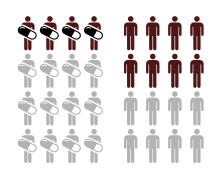In epidemiology, the relative risk reduction (RRR) or efficacy is the relative decrease in the risk of an adverse event in the exposed group compared to an unexposed group. It is computed as , where is the incidence in the exposed group, and is the incidence in the unexposed group. If the risk of an adverse event is increased by the exposure rather than decreased, the term relative risk increase (RRI) is used, and it is computed as .[1][2] If the direction of risk change is not assumed, the term relative effect is used, and it is computed in the same way as relative risk increase.[3]

Numerical examples
editRisk reduction
edit| Quantity | Experimental group (E) | Control group (C) | Total |
|---|---|---|---|
| Events (E) | EE = 15 | CE = 100 | 115 |
| Non-events (N) | EN = 135 | CN = 150 | 285 |
| Total subjects (S) | ES = EE + EN = 150 | CS = CE + CN = 250 | 400 |
| Event rate (ER) | EER = EE / ES = 0.1, or 10% | CER = CE / CS = 0.4, or 40% | — |
| Variable | Abbr. | Formula | Value |
|---|---|---|---|
| Absolute risk reduction | ARR | CER − EER | 0.3, or 30% |
| Number needed to treat | NNT | 1 / (CER − EER) | 3.33 |
| Relative risk (risk ratio) | RR | EER / CER | 0.25 |
| Relative risk reduction | RRR | (CER − EER) / CER, or 1 − RR | 0.75, or 75% |
| Preventable fraction among the unexposed | PFu | (CER − EER) / CER | 0.75 |
| Odds ratio | OR | (EE / EN) / (CE / CN) | 0.167 |
Risk increase
edit| Quantity | Experimental group (E) | Control group (C) | Total |
|---|---|---|---|
| Events (E) | EE = 75 | CE = 100 | 175 |
| Non-events (N) | EN = 75 | CN = 150 | 225 |
| Total subjects (S) | ES = EE + EN = 150 | CS = CE + CN = 250 | 400 |
| Event rate (ER) | EER = EE / ES = 0.5, or 50% | CER = CE / CS = 0.4, or 40% | — |
| Variable | Abbr. | Formula | Value |
|---|---|---|---|
| Absolute risk increase | ARI | EER − CER | 0.1, or 10% |
| Number needed to harm | NNH | 1 / (EER − CER) | 10 |
| Relative risk (risk ratio) | RR | EER / CER | 1.25 |
| Relative risk increase | RRI | (EER − CER) / CER, or RR − 1 | 0.25, or 25% |
| Attributable fraction among the exposed | AFe | (EER − CER) / EER | 0.2 |
| Odds ratio | OR | (EE / EN) / (CE / CN) | 1.5 |
See also
editReferences
edit- ^ Porta, Miquel, ed. (2014). "A Dictionary of Epidemiology". Dictionary of Epidemiology - Oxford Reference. Oxford University Press. doi:10.1093/acref/9780199976720.001.0001. ISBN 9780199976720. Retrieved 2018-05-09.
- ^ Szklo, Moyses; Nieto, F. Javier (2019). Epidemiology : beyond the basics (4th. ed.). Burlington, Massachusetts: Jones & Bartlett Learning. p. 97. ISBN 9781284116595. OCLC 1019839414.
- ^ J., Rothman, Kenneth (2012). Epidemiology : an introduction (2nd ed.). New York, NY: Oxford University Press. p. 59. ISBN 9780199754557. OCLC 750986180.
{{cite book}}: CS1 maint: multiple names: authors list (link)



